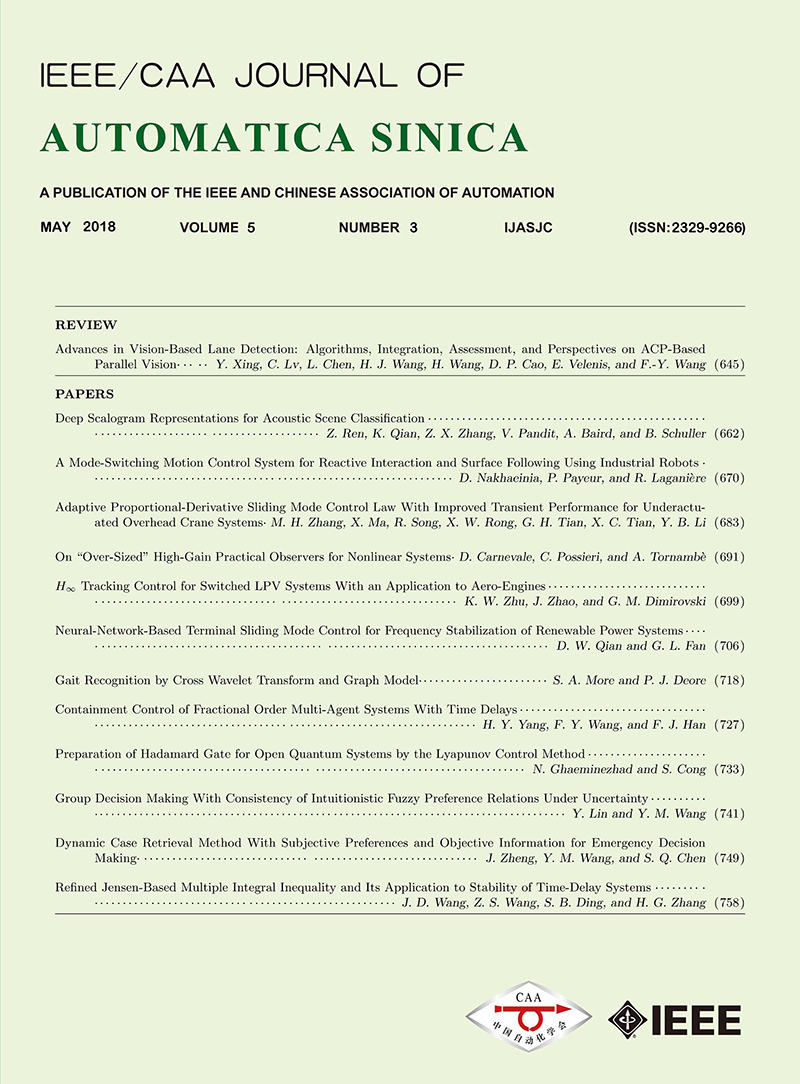 Volume 2
Issue 3
Volume 2
Issue 3
IEEE/CAA Journal of Automatica Sinica
| Citation: | Yumei Li, Holger Voos, Mohamed Darouach and Changchun Hua, "An Algebraic Detection Approach for Control Systems under Multiple Stochastic Cyber-attacks," IEEE/CAA J. of Autom. Sinica, vol. 2, no. 3, pp. 258-266, 2015. |

| [1] |
Bier V, Oliveros S, Samuelson L. Choosing what to protect:strategic defensive allocation against an unknown attacker. Journal of Public Economic Theory, 2007, 9(4):563-587
|
| [2] |
Amin S, Schwartz G A, Sastry S S. Security of interdependent and identical networked control systems. Automatica, 2013, 49(1):186-192
|
| [3] |
Slay J, Miller M. Lessons learned from the Maroochy water breach. Critical Infrastructure Protection, 2007, 253:73-82
|
| [4] |
Andersson G, Esfahani P M, Vrakopoulou M, Margellos K, Lygeros J, Teixeira A, Dan G, Sanderg H, Johansson K H. Cyber-security of SCADA systems. Session:Cyber-Physical System Security in a Smart Grid Environment, 2011.
|
| [5] |
Mo Y L, Sinopoli B. False data injection attacks in control systems. In:Proceedings of the 1st Workshop on Secure Control Systems. Stockholm, Sweden, 2010.
|
| [6] |
Amin S, Litrico X, Sastry S, Bayen A M. Cyber security of water SCADA systems:(I) analysis and experimentation of stealthy deception attacks. IEEE Transactions on Control Systems Technology, 2013, 21(5):1963-1970
|
| [7] |
Eliades D G, Polycarpou M M. A fault diagnosis and security framework for water systems. IEEE Transactions on Control Systems Technology, 2010, 18(6):1254-1265
|
| [8] |
Metke A R, Ekl R L. Security technology for smart grid networks. IEEE Transactions on Smart Grid, 2010, 1(1):99-107
|
| [9] |
Sridhar S, Hahn A, Govindarasu M. Cyber-physical system security for the electric power grid. Proceedings of the IEEE, 2012, 100(1):210-224
|
| [10] |
Mohsenian-Rad A H, Leon-Garcia A. Distributed internet-based load altering attacks against smart power grids. IEEE Transactions on Smart Grid, 2011, 2(4):667-674
|
| [11] |
Sardana A, Joshi R C. Dual-level attack detection and characterization for networks under DDoS. In:Proceedings of the 2010 International Conference on Availability, Reliability and Security. Krakow:IEEE, 2010. 9-16
|
| [12] |
Weimer J, Kar S, Johansson K H. Distributed detection and isolation of topology attacks in power networks. In:Proceedings of the 2012 HiCoNS012. Beijing, China, 2012. 17-18
|
| [13] |
Liu Y, Reiter M K, Ning P. False data injection attacks against state estimation in electric power grids. In:Proceedings of the 2009 ACM Conference on Computer and Communications Security. Chicago, IL, USA:ACM, 2009. 21-32
|
| [14] |
Rosich A, Voos H, Li Y M, Darouach M. A model predictive approach for cyber-attack detection and mitigation in control systems. In:Proceedings of the 52nd Annual Conference on Decision and Control. Firenze:IEEE, 2013. 6621-6626
|
| [15] |
Li Y M, Voos H, Rosich A, Darouach M. A stochastic cyber-attack detection scheme for stochastic control systems based on frequencydomain transformation technique. In:Proceedings of the 8th International Conference on Network and System Security. Xi'an, China:Springer, 2014. 209-222
|
| [16] |
Li Y M, Voos H, Darouach M. Robust H∞ fault estimation for control systems under stochastic cyber-attacks. In:Proceedings of the 33rd Chinese Control Conference. Nanjing, China:ORBilu, 2014. 3124-3129
|
| [17] |
Hashim F, Kibria M R, Jamalipour A. Detection of DoS and DDoS attacks in NGMN using frequency domain analysis. In:Proceedings of the 14th Asia-Pacific Conference on Communications. Tokyo:IEEE, 2008. 1-5
|
| [18] |
Sundaram S, Hadjicostis C N. Distributed function calculation via linear iterative strategies in the presence of malicious agents. IEEE Transactions on Automatic Control, 2011, 56(7):1495-1508
|
| [19] |
Teixeira A, Sandberg H, Johansson K H. Networked control systems under cyber attacks with applications to power networks. In:Proceedings of the 2010 American Control Conference. Baltimore, MD:IEEE, 2010. 3690-3696
|
| [20] |
Pasqualetti F, Bichi A, Bullo F. Consensus computation in unreliable networks:a system theoretic approach. IEEE Transactions on Automatic Control, 2012, 57(1):90-104
|
| [21] |
Johansson K H. The quadruple-tank process:a multivariable laboratory process with an adjustable zero. IEEE Transactions on Control Systems Technology, 2000, 8(3):456-465
|
| [22] |
Zhou K M, Doyle J C, Glover K. Robust and Optimal Control. Upper Saddle River, NJ, USA:Prentice-Hall, Inc., 1996.
|